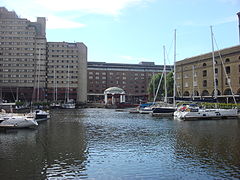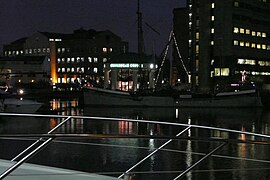
The Jubilee line is a London Underground line that runs between Stratford in east London and Stanmore in the suburban north-west, via the Docklands, South Bank and West End. Opened in 1979, it is the newest line on the Underground network, although some sections of track date back to 1932 and some stations to 1879.

St Katharine Docks is a former dock and now a mixed-used district in Central London, in the London Borough of Tower Hamlets and within the East End. It lies on the north bank of the River Thames, immediately downstream of the Tower of London and Tower Bridge. From 1828 to 1968, it was one of the commercial docks that made up the Port of London. It is in the redevelopment zone known as Docklands and is now a popular housing and leisure complex.

The Jubilee Line Extension (JLE) is the extension of the London Underground Jubilee line from Green Park to Stratford through south and east London. An eastward extension of the line was first proposed in the 1970s. As part of the development of London Docklands, the line was extended to serve Canary Wharf and other areas of south and east London. Construction began in 1993, and it opened in stages from May to December 1999.

The Crown Jewels of the United Kingdom, originally the Crown Jewels of England, are a collection of royal ceremonial objects kept in the Tower of London which include the coronation regalia and vestments worn by British monarchs.

The Apollo command and service module (CSM) was one of two principal components of the United States Apollo spacecraft, used for the Apollo program, which landed astronauts on the Moon between 1969 and 1972. The CSM functioned as a mother ship, which carried a crew of three astronauts and the second Apollo spacecraft, the Apollo Lunar Module, to lunar orbit, and brought the astronauts back to Earth. It consisted of two parts: the conical command module, a cabin that housed the crew and carried equipment needed for atmospheric reentry and splashdown; and the cylindrical service module which provided propulsion, electrical power and storage for various consumables required during a mission. An umbilical connection transferred power and consumables between the two modules. Just before reentry of the command module on the return home, the umbilical connection was severed and the service module was cast off and allowed to burn up in the atmosphere.

In Arthur C. Clarke's Space Odyssey series, Monoliths are machines in black cuboids whose sides extend in the precise ratio of 1 : 4 : 9 (12 : 22 : 32) built by an unseen extraterrestrial species whom Clarke dubbed the Firstborn and whom he suggests are the earliest highly intelligent species to evolve in the Milky Way. In the series of novels (and the films based on these), three Monoliths are discovered in the Solar System by australopithecines and their human descendants. The response of the characters to their discovery drives the plot of the series. It also influences the fictional history of the series, particularly by encouraging humanity to progress with technological development.

The Shining is a 1980 psychological horror film produced and directed by Stanley Kubrick and co-written with novelist Diane Johnson. The film is based on Stephen King's 1977 novel of the same name and stars Jack Nicholson, Shelley Duvall, Scatman Crothers, and Danny Lloyd. The film's central character is Jack Torrance (Nicholson), an aspiring writer and recovering alcoholic who accepts a position as the off-season caretaker of the isolated historic Overlook Hotel in the Colorado Rockies, with his wife, Wendy Torrance (Duvall), and young son, Danny Torrance (Lloyd). Danny is gifted with psychic abilities named "shining". After a winter storm leaves the Torrances snowbound, Jack's sanity deteriorates due to the influence of the supernatural forces that inhabit the hotel.

2001: A Space Odyssey is a 1968 science fiction novel by British writer Arthur C. Clarke. It was developed concurrently with Stanley Kubrick's film version and published after the release of the film. Clarke and Kubrick worked on the book together, but eventually only Clarke ended up as the official author. The story is based in part on various short stories by Clarke, including "The Sentinel". By 1992, the novel had sold three million copies worldwide. An elaboration of Clarke and Kubrick's collaborative work on this project was made in the 1972 book The Lost Worlds of 2001.
The Queen Elizabeth II Silver Jubilee Medal is a commemorative medal created in 1977 to mark the 25th anniversary of Queen Elizabeth II's accession in 1952. The medal is physically identical in all realms where it was awarded, save for Canada, where it contained unique elements. As an internationally distributed award, the Queen Elizabeth II Silver Jubilee Medal holds a different place in each country's order of precedence for honours.

The Queen Elizabeth II Coronation Medal is a commemorative medal instituted to celebrate the coronation of Queen Elizabeth II on 2 June 1953.

The Jubilee Walkway is an official walking route in London. It was originally opened as the Silver Jubilee Walkway to commemorate Queen Elizabeth II's accession; the Queen herself opened it on 9 June 1977 during her silver jubilee celebrations. The intention was to connect many of London's major tourist attractions and it is now one of seven such walks within the Mayor of London's strategic walking routes. Its length is 15 miles.

The Tower Hotel is a large hotel situated on the north bank of the River Thames, on the east side of Tower Bridge, in London.

Havengore is a former hydrographic survey launch, originally launched in 1956 for service with the Port of London Authority (PLA). After her withdrawal from service and sale in 1995, she was re-registered as a passenger vessel for up to 40 passengers. Based on the River Thames, Havengore has also served as a ceremonial vessel. She is best known for carrying the body of Sir Winston Churchill as part of his state funeral in 1965.
Since its premiere in 1968, the film 2001: A Space Odyssey has been analysed and interpreted by numerous people, ranging from professional movie critics to amateur writers and science fiction fans. The director of the film, Stanley Kubrick, and the writer, Arthur C. Clarke, wanted to leave the film open to philosophical and allegorical interpretation, purposely presenting the final sequences of the film without the underlying thread being apparent; a concept illustrated by the final shot of the film, which contains the image of the embryonic "Starchild". Nonetheless, in July 2018, Kubrick's interpretation of the ending scene was presented after being newly found in an early interview.

Tower Bridge Quay previously St. Katharine's Pier, is a river transport pier on the River Thames, in London, UK. It is owned & operated by Woods River Cruises trading as Woods’ Silver Fleet and served by various river transport and cruise operators.

2001: A Space Odyssey is a 1968 epic science fiction film produced and directed by Stanley Kubrick. The screenplay was written by Kubrick and science fiction author Arthur C. Clarke, and was inspired by Clarke's 1951 short story "The Sentinel" and other short stories by Clarke. Clarke also published a novelisation of the film, in part written concurrently with the screenplay, after the film's release. The film stars Keir Dullea, Gary Lockwood, William Sylvester, and Douglas Rain, and follows a voyage by astronauts, scientists and the sentient supercomputer HAL to Jupiter to investigate an alien monolith.

The Thames Diamond Jubilee Pageant was a parade on 3 June 2012 of 670 boats on the Tideway of the River Thames in London as part of the celebrations of the Diamond Jubilee of Elizabeth II. The Queen, Prince Philip and other members of the Royal Family were aboard vessels that took part in the parade. The parade was organised by the Thames Diamond Jubilee Foundation, and funded by private donations and sponsorship. The pageant master was Adrian Evans.
Arthur Fleischmann was a Slovak-born, London-based sculptor, who pioneered the use of perspex in sculpture. He spent time in Bali, and in Australia, where he was at the centre of the Merioola Group, before settling in London.

The Silver Jubilee of George V on 6 May 1935 marked 25 years of George V as the King of the United Kingdom and the British Dominions, and Emperor of India. The Jubilee was marked with large-scale and popular events throughout London and the rest of the United Kingdom in May 1935. It was the first ever Silver Jubilee celebration of any British monarch in history. The King died less than a year later.




















